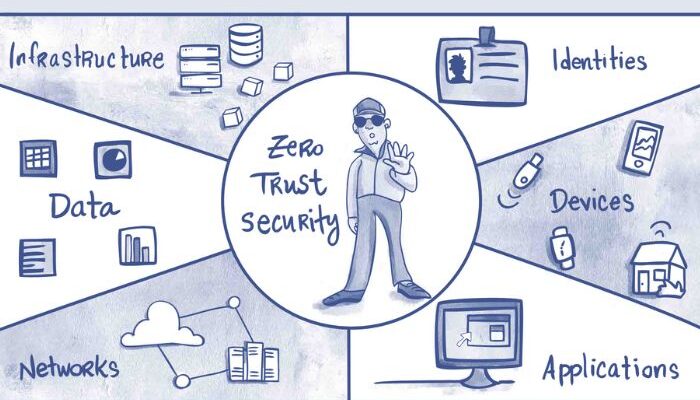Introduction to Zero Trust
In the landscape of cybersecurity, where digital threats loom large, the Zero Trust model emerges as a beacon of resilience. Born from the simple premise of “never trust, always verify,” Zero Trust is fundamentally reshaping the cybersecurity narrative. This strategy shifts the focus from perimeter-based defenses to a model where security is granular and pervasive, inspecting every connection and transaction. For businesses navigating the complexities of modern digital initiatives, adopting a zero trust architecture ensures vigilance against external threats while bolstering defenses against internal vulnerabilities.
As digital landscapes become more interconnected and dynamic, the imperative for Zero Trust intensifies. The expansion of remote work and cloud services has dismantled traditional network perimeters, rendering them ineffective against contemporary threats. Therefore, Zero Trust is not only a precautionary measure but also a strategic requirement for preserving data secrecy and integrity across decentralized networks.
Traditional Security vs. Zero Trust
Traditional cybersecurity strategies often rely on the establishment of a secure and trusted perimeter, creating a thin line between internal network sanctity and external chaos. Despite their historical utility, these models falter against sophisticated threats, bypassing security gates through phishing or exploiting trusted internal actors. In stark contrast, Zero Trust models encapsulate a security-first mindset into every network interaction. Rather than assuming trust based on geographical or network origin, Zero Trust models rigorously authenticate and authorize every request, ensuring that access is granted exclusively to validated and legitimate entities.
This distinction became clear in a recent analysis of Zero Trust versus traditional models, revealing the systematic advantages of perpetual verification. By retiring the outdated adage that threats exclusively originate outside the network, Zero Trust frameworks work proactively to identify and isolate potential breaches within the organization before they blossom into significant threats.
Core Principles of Zero Trust
Implementing Zero Trust requires adherence to its core principles: “Verify explicitly,” “Use least privilege access,” and “Assume breach.” Verifying explicitly ensures that each access request undergoes stringent verification processes involving both identity and context. This means every user and device must continually prove their legitimacy, irrespective of their internal or external status.
The principle of using the least privileged access is fundamental to minimizing threats by ensuring that users receive the minimal level of access necessary for their role, reducing potential exposure from compromised accounts. Lastly, by assuming a breach, organizations design their security architecture with the expectation that breaches will occur, constantly reinforcing defenses and reducing potential impacts through proactive measures.
Implementation Steps in Zero Trust
Successfully integrating Zero Trust into an organization involves a series of definitive steps. Initially, organizations should focus on identifying and classifying data based on its importance and sensitivity, allowing them to allocate resources appropriately. This data-centric approach ensures that the most critical assets receive heightened protection.
After classification, mapping the data flow becomes crucial. Understanding how data traverses through and interacts with network systems helps identify existing vulnerabilities and streamline the security measures required. Implementing a least privilege access model follows, where access permissions are tightly controlled and continuously reviewed to suit evolving roles and responsibilities. Finally, maintaining rigorous monitoring and logging of activities is imperative to creating a transparent and accountable security infrastructure that can swiftly react to anomalies as they arise.
Benefits of a Zero Trust Model
The advantages of adopting a Zero Trust model are extensive. One of the primary benefits is a marked reduction in the risk of data breaches. By scrutinizing every access point, organizations can deter unauthorized access, significantly decreasing the likelihood of successful cyberattacks. Furthermore, the model aids in compliance with stringent regulatory requirements, ensuring that organizations can fulfill data protection mandates with ease.
Beyond security, Zero Trust models enhance the user experience. By employing seamless authentication processes, they eliminate bottlenecks and inefficiencies, enabling legitimate users to access resources quickly and securely. This balance of security and efficiency highlights Zero Trust as a catalyst for both protective measures and operational enhancements.
Real-World Applications of Zero Trust
Industries across the globe are embracing the Zero Trust philosophy, recognizing its capacity to safeguard crucial infrastructures. The financial sector, for instance, is increasingly relying on Zero Trust to thwart unauthorized attempts to access sensitive customer information. By enhancing network segmentation and implementing multifactor authentication, these institutions have successfully fortified their systems.
A recent article on Zero Trust adoption highlights its application beyond finance, extending to healthcare, where protecting patient data is of utmost importance, and technology firms, where safeguarding intellectual property is critical. Such adoption underscores the growing acknowledgment of Zero Trust as a fundamental element of comprehensive cybersecurity strategies.
Challenges and Considerations
Despite its benefits, transitioning to a Zero Trust model can present challenges. A common hurdle is the perceived complexity and cost associated with deploying new security measures across an organization. Additionally, cultural resistance often emerges as stakeholders adjust to a shift from traditional models to more rigorous security protocols.
To overcome these barriers, organizations should engage in meticulous planning, ensuring the transition is gradual, sustainable, and inclusive of stakeholder input. Investing in technologies and solutions specifically designed to support Zero Trust frameworks will also aid in alleviating the operational burden and financial outlay associated with implementation.
Future Trends in Zero Trust
Looking ahead, the trajectory of Zero Trust suggests evolving integration with emerging technologies such as artificial intelligence (AI) and the Internet of Things (IoT). As these technologies become more pervasive, their incorporation into Zero Trust models will not only automate threat detection but also provide predictive insights, enhancing security measures in real-time.
As organizations continue to navigate complex digital and hybrid environments, Zero Trust is poised to evolve concurrently, expanding its influence in securing not just IT infrastructures but entire business ecosystems. Such adaptability ensures that Zero Trust remains at the forefront of security innovation and resilience.

















Comments